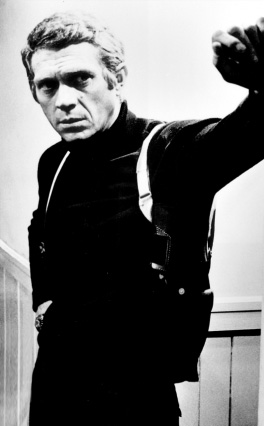There’s more to Bullitt than just that car chase
Wednesday, May 2nd, 2012 • Movies / Writing
 There’s more to Bullitt than just that car chase, even if there doesn’t need to be—the famous 110-mile-per-hour Charger vs. Mustang duel (where the shocks blow out and the cars bounce over the hilltops like skateboarders) comes at you like the stargate in 2001 earlier that year. Bullitt is so 1968 it hurts, but, even during the Year of the Battlements, Steve McQueen manages to be the quietest action hero in history—he’s so low key he makes Dirty Harry look like latter-day Pacino (say, Heat-era Pacino) in comparison.
There’s more to Bullitt than just that car chase, even if there doesn’t need to be—the famous 110-mile-per-hour Charger vs. Mustang duel (where the shocks blow out and the cars bounce over the hilltops like skateboarders) comes at you like the stargate in 2001 earlier that year. Bullitt is so 1968 it hurts, but, even during the Year of the Battlements, Steve McQueen manages to be the quietest action hero in history—he’s so low key he makes Dirty Harry look like latter-day Pacino (say, Heat-era Pacino) in comparison.
Bullitt is all bleached-out San Francisco sunlit streets (viewed between garish street billboards and through warped, taped-together welfare-hotel windows) with jaded-looking crowds in ties and Foster Grants. Peter Yates’ handheld Arriflex tracks in on an identikit with a blank face, while McQueen (as Frank Bullitt) stands in front of an old-school Coke machine in his famous turtleneck-and-blazer, concealing his custom-made fast-draw holster (which was apparently copied from the real article used by legendary San Francisco homicide detective David Toshi, who was played by Mark Ruffalo in David Fincher’s Byzantine Zodiac—another great San Francisco movie, in which we watch completely-synthetic CGI “stop-motion” footage of the Transamerica building’s construction and Matte World Digital provides the period “Hair” billboards on the virtualized brick walls flanking the shooting crime scenes). Robert Duvall shows up as a cab driver, four years before becoming Tom Hagen (and four years before Woody Allen would anachronistically play a happy, contented San Francisco resident in Play It Again, Sam).
San Francisco is a cinematic dreamworld for me, going all the way back to my terrifying first viewing of Invasion of the Body Snatchers (1979), in which the Transamerica building is in practially every shot (back then, they owned United Artists). The big hotel that oily Robert Vaughn first appears in reminds me of that enormous wedding-cake apartment building from Vertigo. Bullitt gets pulled into a criminal conspiracy and has to deal with wounded partners and corruption, but it never makes him raise his voice (or fire his gun, until the end); even Gary Cooper looked like he wanted to talk but was preventing himself, while McQueen manages to make it seem like every sentence has to be pulled out of him by coercive force. He doesn’t have to get the girl; as established at the beginning of the movie, he’s already got the girl (Jacqueline Bissett, who walks around in the morning wearing nothing but his dress shirt from the night before, magnificently), an architect who repeatedly begs him to “let her in” but, like a Rolling Stones wife, knows when to back off and smile, eating shredded wheat while the front door slams on the soundtrack.
If Bullitt had been a product of the Joel Silver and Jerry Bruckheimer era, there would have been more of them, and Bissett would probably have returned (along with Norman Fell as Bullitt’s irritated boss, and maybe even Duvall as that cab driver—he would have gotten other jobs, like the Joe Pesci character in the Lethal Weapon sequels). Bissett would keep trying to get Bullitt to open up, and he would keep refusing and flashing his blue eyes at her blue eyes and putting on his turtleneck and leaving. They would keep trying to top that car chase, unless they were smart enough to just give up and try something else (maybe Harbor Patrol speedboats), but I doubt they would manage to be quite that smart; according to IMDB, McQueen worked it out with Peter Yates to tilt his head the right way so that viewers would know for sure that he was driving the famous “Bullitt Mustang” himself (most of the time). I would have gone to see all of them, over the next few years, watching Steve McQueen’s sideburns get longer (Pauline Kael pointed out that John Wayne’s ill-conceived mid-seventies cop thriller McQ gave away its star’s slavish need to get on what she called the “Urban Western” bandwagon simply through its title).
Russell Crowe may be a latter-day near-miss-copy of Richard Burton, and, in the same way, Daniel Craig currently functions as a reflected shadow of McQueen (and his James Bond owes a great deal to Kael’s “Urban Western” tradition). But there’s just nothing like the original; standing absolutely still in a doorway, McQueen conveyed more narrative force than a dozen impassioned monologues from a dozen other movie stars combined. And he could drive.